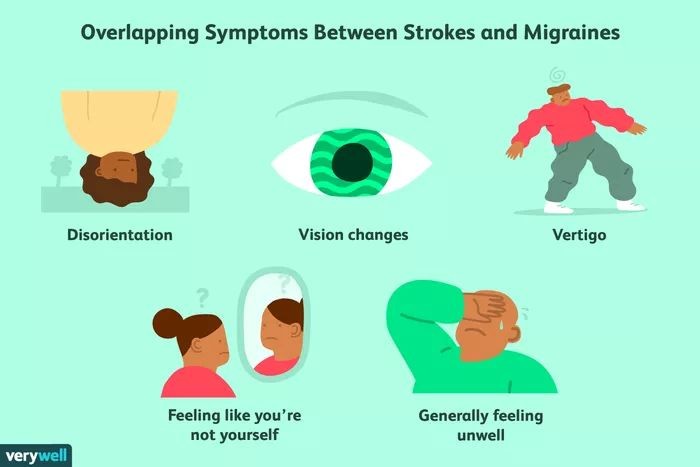
Contents
Migraine and Stroke
A migraine is a neurological condition that typically includes a throbbing headache, usually on one side of the head. The causes of migraines are not fully understood, but changes in brain chemicals and genetics may play a role.
Migraine with Aura
A migraine "aura" refers to neurological symptoms that occur before a migraine attack. These symptoms can include vision problems, sensations, speech difficulties, and motor function issues. Migraine aura symptoms are usually temporary and may occur on one side of the body or visual field. After the aura, a migraine attack typically follows.
Migraine aura symptoms resemble those of stroke or transient ischemic attack (TIA). If you suspect a stroke, remember "FAST."
Stroke
A stroke, or "brain attack," occurs when a blood vessel in the brain is blocked, leaks, or bursts. This deprives brain cells of oxygen and can lead to varying degrees of loss of bodily function. There are two main types of stroke: hemorrhagic and ischemic. The latter can present as a mini-stroke, also known as a transient ischemic attack (TIA).
A stroke is a medical emergency. Immediate attention is necessary.
Migraine Versus Stroke
Migraines can feel similar to stroke, especially when accompanied by a headache. Migraine aura may resemble a TIA, which is a temporary stroke that quickly resolves without long-term effects.
Migraine Symptoms
Migraine attacks can last for hours and cause severe pain, visual disturbances, nausea, dizziness, sensitivity to stimuli, and tingling or numbness in the extremities or face.
Stroke Symptoms
- Facial drooping, numbness, or an asymmetrical smile
- Weakness or numbness in the arms
- Speech difficulties or confusion
- Trouble understanding speech
- Numbness or weakness on one side of the body
- Visual disturbances
- Dizziness or trouble walking
- Sudden severe headache with no known cause
Stroke is a medical emergency. Learn the signs of a stroke and act quickly.
Migraines and Stroke
Migraines and strokes can occur simultaneously, but no definitive causal link has been established. When an ischemic stroke happens during a migraine attack, it is called a migrainous infarction.
Migraine and Stroke Risk Factors
In some cases, migraines may be associated with a higher stroke risk, particularly for those with migraine with aura. Individuals with traditional stroke risk factors, such as high blood pressure, diabetes, high cholesterol, smoking, and obesity, are at even greater risk.
Immediate medical attention is necessary for stroke symptoms.
Migraine and Stroke Treatments
Treating Migraines
While there is no cure for migraines, they can be managed with various treatments:
- Over-the-counter pain relievers, triptans, and ergot derivatives can provide acute relief.
- Antidepressants, anticonvulsants, beta-blockers, calcium channel blockers, and hormonal therapy may help prevent attacks.
- Lifestyle changes, such as avoiding triggers, maintaining a healthy diet, exercising, and stress reduction, can also be beneficial.
- Alternative treatments like biofeedback, acupuncture, and counseling may offer additional support.
Treating Stroke
Stroke is a medical emergency. Call 911 immediately.
A CT scan is necessary to differentiate between ischemic and hemorrhagic strokes, as their treatments differ. Blood thinners, such as alteplase, may be given in emergency situations for acute ischemic stroke. Carotid endarterectomy or angioplasty may be performed to open blocked carotid arteries. Hemorrhagic strokes require reducing bleeding and managing blood pressure through medications, antiplatelet agents, or surgery.


